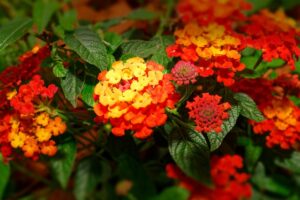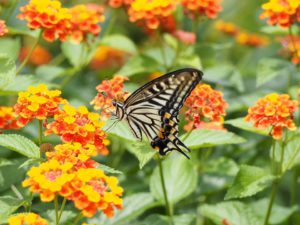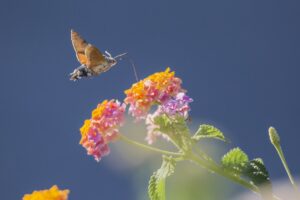Lantana Plants Grow Guide

The lantana plant is a hardy perennial that’s native to the tropical regions of the Americas and Africa, this garden beauty belongs to the family Verbenaceae and goes by the common names wild sage or button sage. I love lantanas because of their beautiful multi-color flower bloom that remains me of a rainbow. I have worked with lantanas on many garden projects in fact, I am growing a few of them as potted plants on my porch and have installed a few in my home garden.
What also makes lantanas a must-have is their versatility thriving in the most adverse conditions these garden beauties will attract butterflies, bees, hummingbirds, and other types of nectar-eating birds. Lantanas can withstand the drought as well as salt sprays in coastal areas and carries an aroma that is mild and pleasant although the fragrance may not appeal to some.
In warmer climates, lantanas can be grown as a perennial but in colder climates as annuals. To successfully grow and care for the lantana plant continue reading to see how easy it’s done.
Lighting Requirements
Because lantanas are tropical plants they love the full sun so ensure to place your pot/pots in an outdoor area that meets their requirements. At least 6 hours of sunlight per day.
Lantana Soil Type
Potted lantanas should be installed in a good potting mix, to improve drainage add perlite, sand, or vermiculite.
Potted Lantana Water Requirements
More damage has been done by watering potted plants that have grown from containers than growing directly in the ground. Because lantanas are considered to be drought-tolerant check the top 1 to 2 inches of soil. If the soil feels dry to the touch then give your lantanas a good soaking and don’t water again until the top 1 to 2 inches of soil feels dry to the touch.
Potted Lantana Fertilizer Requirements
When growing lantanas in pots ensure they are properly fed so they can continue to grow healthy and also to produce an abundance of colorful flower blooms. A well-balanced slow-release or water-soluble fertilizer is ideal. Before fertilizer application read and follow the manufacturer’s directions for the best results.
Deadheading your Potted Lantanas
To keep your lantanas beautiful and healthy looking spent, Faded or dead flowers should be removed, faded flowers can be removed by pinching. This action will encourage your lantanas to produce fresh healthy flower blooms.
Garden Insect Pests of Lantanas

Keep an eye out for these garden insect pests.
- Aphids
- Mealybugs
- Lantana leaf blotch miner
- Spider Mites
- Whiteflies
- Lace Bugs
Aphids
Aphids are tiny pear-shaped insects that are included in the family of the sucking insect pests, these insects will suck the plant’s fluids causing yellowing and leaf drop. Aphids are among the easiest garden insect pests to control. A strong spray of water from your garden hose will knock them off garden plants eliminating them or the use of insecticidal soap will also help.
Mealybugs
Mealybugs are tiny white insects that have the appearance of cotton, these garden insect pests remain in a fixed position on garden plants although if observed closely move very, very, slow especially when disturbed.
They also do damage as aphids when their feed, producing a sticky substance known as honeydew which is the waste that ants feed on. Honeydew will also cause mold to form known as sooty mold which will not only take away from the beauty of garden plants but will interfere with photosynthesis ( blocking out the sunlight) which enables plants to manufacture their foods. The use of insecticidal soap or horticultural oil will bring them under control.
Lantana leaf blotch miner
The adult fly is shiny, small, and black, this garden insect pest feeds inside of the lantana leaves, causing a trail of white blotch to appear. The larva is white-yellowish, control methods include the removal and proper disposal of infected plant parts and the use of pesticides which are labeled for control.
Spider Mites
Spider mites are very tiny insects that are hard to detect, signs that your lantana has spider mites may include webbing on the plant, and your lantanas may also take on a dusty appearance. A sure test to know if the culprits are spider mites is to hold a white sheet of paper under the stem and leaves, and gently sake if spider mites are present you will see tiny specks moving around on that white sheet of paper. You may also feel them crawling on your hands, the use of insecticidal soap or horticultural will bring them under control.
Whiteflies
Whiteflies are tiny white insects that dose damage as mealybugs, spider mites, and aphids. They are easy to notice, gently shake the leaves and if the infestation is whiteflies they will quickly dislodge from your lantana but will quickly reattach to the plant just as fast. Neem oil or insecticidal soap has proven to be effective.
Lace Bugs
The eggs of the adult are laid on the underside of the plant’s leaves this is where feeding takes place, as bugs feed will cause the top side of the infected leaves to develop white, yellow, or brown specks.
In server conditions, the leaves will turn yellow and brown followed by the leaf drop. Infected parts should be pruned and properly disposed of. The use of systemic pesticides such as acephate will bring control and elimination of these garden pests.

Diseases of lantanas
Keep a watch for diseases.
- Root Rot
- Botrytis Blight
- Powdery Mildew
Root Rot
Root rot occurs either because of overwatering or poor soil drainage. The soil should have good drainage along with being somewhat moist and not waterlogged or saturated.
Botrytis Blight
Overhead irrigation is responsible for this disease, to prevent botrytis blight, water lantanas from the ground level during the morning hours which will give the plant time to dry if water makes contact with the leaves.
Symptoms of botrytis blight show up as leaves developing brown spots that are wet followed by gray mold covering the leaves. Applying a fungicide that contains chlorothalonil will bring control.
Powdery Mildew
Powdery mildew appears as a white powdery substance on the plant leaves and stems hence the name. This disease is brought on by full sun-loving plants that are grown in the shade along with plants that are crowded which encourages poor air circulation.
This fungus may cause leaves to become distorted and discolored. The use of neem oil or baking soda will offer a solution.
How to Overwinter Your Potted Lantanas
As the winter months approach lantanas should be brought indoors before the first frost during the fall months, the pot or container should be placed in a room that receives bright indirect sunlight. The room should also be cool, during the winter months cut back on the amount of water, water just enough to keep the soil moist. Once spring returns gradually acclimate your lantanas outdoors at nightime when the temperatures are consistently 55 degrees F or above.
The final word on how to grow lantanas in pots
Lantanas are one of my favorite garden plants, these garden beauties deserve our attention, if you want a garden that gives that color pop then look no further lantanas are the ideal plants. Lantana flower plants are drought-resistance, beautiful, and attract wildlife and pollinators this plant is a winner. Join the many homeowners who are taking advantage of these flowering beauties.
About the author
Norman loves being in the garden, both at home and for his job....
he is 'Natures Little helper' being outdoors, growing his vegetables and flowers from an early age.
Now having spent over 22 years in the profession he want to give some of his knowledge to others...
his vast array of hints and tips you will find scattered over this site will help you no end growing plants in your garden.
